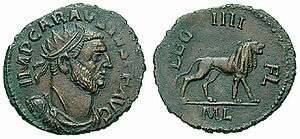Legio IV Flavia Felix
Legio quarta Flavia Felix ("Lucky Flavian Fourth Legion"), was a legion of the Imperial Roman army founded in AD 70 by the emperor Vespasian (r. 69–79) from the cadre of the disbanded Legio IV Macedonica. The legion was active in Moesia Superior in the first half of the 5th century. The legion symbol was a lion.


History
During the Batavian rebellion, the IV Macedonica fought for Vespasian, but the emperor distrusted his men, probably because they had supported Vitellius two years before. Therefore IV Macedonica was disbanded, and a new Fourth legion, called Flavian Felix was levied by the emperor, who gave the legio his nomen, Flavia. Since the symbol of the legion is a lion, it was probably levied in July/August 70.
IV Flavia Felix was camped in Burnum, Dalmatia (modern Kistanje), where it replaced XI Claudia. After the Dacian invasion of 86, Domitian moved the legion to Moesia Superior, in Singidunum (modern Belgrade, Serbia), although there is some evidence of the presence of this legion, of one of its vexillationes in Viminacium (near modern-day Kostolac, Serbia), base of VII Claudia.
In 88 the Fourth participated to the retaliation invasion of Dacia (see Domitian's Dacian War). It also participated in the Dacian Wars of Trajan, being victorious at the Second Battle of Tapae. The legion also participated at the final and decisive battle against the Dacians, conquering their capital, Sarmisegetusa.

Monuments of IV Flavia Felix have been found at Aquincum (Budapest). This suggests that a subunit replaced II Adiutrix during its absence during the wars of Lucius Verus against the Parthian empire (162-166).
In the Marcomannic Wars (166–180), the fourth fought on the Danube against the Germanic tribes.
After the death of Pertinax, the IV Flavia Felix supported Septimius Severus against usurpers Pescennius Niger and Clodius Albinus.
The legion may have fought in one of the several wars against the Sassanids, but stayed in Moesia Superior until the first half of the 5th century.
Attested members
| Name | Rank | Time frame | Province | Source |
|---|---|---|---|---|
| Calventius Viator | centurio | between 100 and 110 | Moesia Superior | |
| Gaius Octavius Tidius Tossianus Lucius Javolenus Priscus | legatus legionis | c. 80 | CIL III, 2864 | |
| Titus Julius Maximus Manlianus | legatus legionis | c. 105 | Moesia Superior | CIL XII, 3167 |
| [...] Serenus[1] | legatus legionis | c. 160 | Moesia Superior | AE 1965, 243 |
| Gaius Julius Avitius Alexianus[2] | legatus legionis | c. 195 | Moesia Superior | AE 1921, 64 |
| Gaius Petillius Firmus | military tribune | c. 70 | AE 1967, 355 | |
| Lucius Dasumius Tullius Tuscus | military tribune | c. 140 | Moesia Superior | CIL XI, 3365 |
| Marcus Gavius Priscus Numisius Junior[3] | military tribune | c. 150 | Moesia Superior | CIL X, 8292 |
| Traianus Mucianus | praefectus castrorum | between 268 and 285 | Moesia Superior | |
| Aulus Julius Pompilius Piso[1] | praepositus | c. 175-c. 176 | Moesia Superior | CIL VIII, 2582 |
In popular culture
This Roman Legion was featured in the beginning of the movie Gladiator where Maximus Decimus Meridius was the Legion general, leading the campaign in Germania against the Marcomanni.
References
- Géza Alföldy, Konsulat und Senatorenstand unter der Antoninen (Bonn: Rudolf Habelt, 1977), p. 298
- Paul M. M. Leunissen, Konsuln und Konsulare in der Zeit von Commodus bis Severus Alexander (Amsterdam: J.C. Gieben, 1989), p. 339
- Werner Eck, "M. Gavius Crispus Numisius Iunior als Prokonsul von Lycia-Pamphylia in einer Inschrift aus Perge", Zeitschrift für Papyrologie und Epigraphik , 131 (2000), p. 251–257
External links
- livius.org account of Legio IIII Flavia Felix
- Reenactment Legion based in Southern Ontario, Canada portraying IIII Flavia Felix
